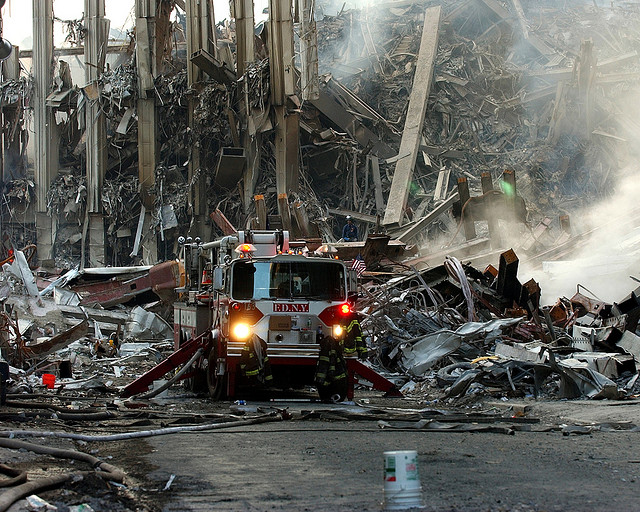Losses stemming from the destruction of the World Trade Center and other buildings by terrorists on Sept. 11, 2001, totaled about $31.6 billion, including commercial liability and group life insurance claims -- not adjusted for inflation -- or $42.1 billion in 2012 dollars. About two-thirds of these losses were paid for by reinsurers, companies that provide insurance for insurers.
Concerned about the limited availability of terrorism coverage in high-risk areas and its impact on the economy, Congress passed the Terrorism Risk Insurance Act (TRIA). The act provides a temporary program that, in the event of major terrorist attack, allows the insurance industry and federal government to share losses according to a specific formula. TRIA was signed into law on Nov. 26, 2002, and renewed for two years in December 2005. Passage of TRIA enabled a market for terrorism insurance to begin to develop because the federal backstop effectively limits insurers’ losses, greatly simplifying the underwriting process. TRIA was extended for seven years to 2014 in December 2007. The new law is known as the Terrorism Risk Insurance Program Reauthorization Act (TRIPRA) of 2007.
This week, Congress failed to reauthorize TRIA before members adjourned for the holiday recess. Now, with the expiration of the law on Dec. 31, some businesses may be left without insurance coverage in the event of a terrorist attack on the U.S. Both houses of Congress have been discussing legislation that would set out the federal government’s involvement in funding potential terrorism losses, but bills proposed by the two houses earlier this year differed, and no extension was passed.
A report from the Wharton Risk Management and Decision Processes Center found that, under the current TRIA program, some insurers have already reached a level of exposure to losses from a terrorist attack that could jeopardize their ability to pay claims, based on a critical measure of solvency: the ratio of an insurer’s TRIA deductible amount in relation to its surplus. The report, "TRIA After 2014: Examining Risk Sharing Under Current and Alternative Designs," found that as the deductible percentage rises, as it does under the Senate bill and proposals put forward in the House, more insurers have a deductible-to-surplus ratio that is above an acceptable level. The report also sets out in detail the amount the American taxpayer and federal government would have to pay under differing scenarios.
A RAND Corp. study published in April 2014 found that in a terrorist attack with losses of as much as $50 billion, the federal government would spend more dealing with the losses than if it had continued to support a national terrorism risk insurance program, because it would likely pay out more in disaster assistance.
A report by the President’s Working Group on Financial Markets made public in April 2014 generally supports the insurance industry’s view that the expiration of TRIA would make terrorism coverage more expensive and difficult to obtain.
The insurance broker Marsh released its annual study of the market, "2014 Terrorism Risk Insurance Report," in April. Among its many findings is that uncertainty surrounding the potential expiration of TRIA significantly affected the property/casualty insurance market. Some employers with large concentrations of workers and companies with property exposures in major U.S. cities found that terrorism insurance capacity was limited and prices higher, and some could not obtain coverage at all. If the law is allowed to expire or is significantly changed, the market is likely to become more volatile with higher prices and limited coverage, the study concludes.
Before Sept. 11, 2001, insurers provided terrorism coverage to their commercial insurance customers essentially free of charge because the chance of property damage from terrorist acts was considered remote. After Sept. 11, insurers began to reassess the risk. For a while, terrorism coverage was scarce. Reinsurers were unwilling to reinsure policies in urban areas perceived to be vulnerable to attack. Primary insurers filed requests with their state insurance departments for permission to exclude terrorism coverage from their commercial policies.
From an insurance viewpoint, terrorism risk is very different from the kind of risks typically insured. To be readily insurable, risks have to have certain characteristics.
The risk must be measurable. Insurers must be able to determine the possible or probable number of events (frequency) likely to result in claims and the maximum size or cost (severity) of these events. For example, insurers know from experience about how many car crashes to expect per 100,000 miles driven for any geographic area and what these crashes are likely to cost. As a result, they can charge a premium equal to the risk they are assuming in issuing an auto insurance policy.
A large number of people or businesses must be exposed to the risk of loss, but only a few must actually experience one, so that the premiums of those that do not file claims can fund the losses of those who do.
Losses must be random as regards time, location and magnitude.
Insofar as acts of terrorism are intentional, terrorism risk doesn't have these characteristics. In addition, no one knows what the worst-case scenario might be. There have been few terrorist attacks, so there is little data on which to base estimates of future losses, either in terms of frequency or severity. Terrorism losses are also likely to be concentrated geographically, since terrorism is usually targeted to produce a significant economic or psychological impact. This leads to a situation known in the insurance industry as adverse selection, where only the people most at risk purchase coverage, the same people who are likely to file claims. Moreover, terrorism losses are never random. They are carefully planned and often coordinated.
To underwrite terrorism insurance -- to decide whether to offer coverage and what price to charge -- insurers must be able to quantify the risk: the likelihood of an event and the amount of damage it would cause. Increasingly, they are using sophisticated modeling tools to assess this risk. According to the modeling firm AIR Worldwide, the way terrorism risk is measured is not much different from assessments of natural disaster risk, except that the data used for terrorism are more subject to uncertainty. It is easier to project the risk of damage in a particular location from an earthquake of a given intensity or a Category 5 hurricane than a terrorist attack because insurers have had so much more experience with natural disasters than with terrorist attacks, and therefore the data to incorporate into models are readily available.
One problem insurers face is the accumulation of risk. They need to know not only the likelihood and extent of damage to a particular building but also the company's accumulated risk from insuring multiple buildings within a given geographical area, including the implications of fire following a terrorist attack. In addition, in the U.S., workers' compensation insurers face concentrations of risk from injuries to workers caused by terrorism attacks. Workers' compensation policies provide coverage for loss of income and medical and rehabilitation treatment from "first dollar," that is, without deductibles.
Extending the Terrorism Risk Insurance Act (TRIA):
There is general agreement that TRIA has helped insurance companies provide terrorism coverage because the federal government's involvement offers a measure of certainty as to the maximum size of losses insurers would have to pay and allows them to plan for the future. However, when the act came up for renewal in 2005 and in 2007, there were some who believed that market forces should be allowed to deal with the problem. Both the U.S. Government Accountability Office and the President’s Working Group on Financial Markets published reports on terrorism insurance in September 2006. The two reports essentially supported the insurance industry in its evaluation of nuclear, biological, chemical and radiological (NBCR) risk -- that it is uninsurable -- but the President’s Working Group said that the existence of TRIA had inhibited the development of a more robust market for terrorism insurance, a point on which the industry disagrees. TRIA is the reason that coverage is available, insurers say. The structure of the program has encouraged the development of reinsurance for the layers of risk that insurers must bear themselves -- deductible amounts and coinsurance -- which in turn allows primary insurers to provide coverage. Without TRIA, there would be no private market for terrorism insurance.
Studies by various organizations have supported a temporary continuation of the program in some form, including the University of Pennsylvania's Wharton School, the RAND Corp. and the Organization of Economic Cooperation and Development (OECD), an organization of 30 member countries, many of which have addressed the risk of terrorism through a public/private partnership. The OECD said in an analysis that financial markets have shown very little appetite for terrorism risk because of the enormousness and unpredictability of the exposure. RAND argued not only that TRIA should be extended but also that Congress should act to increase the business community's purchase of terrorism insurance and lower its price. RAND also advocated mandatory coverage for some "vital systems," establishing an oversight board and increasing efforts to mitigate the risks.
For the full report from which this is excerpted,
click here.


